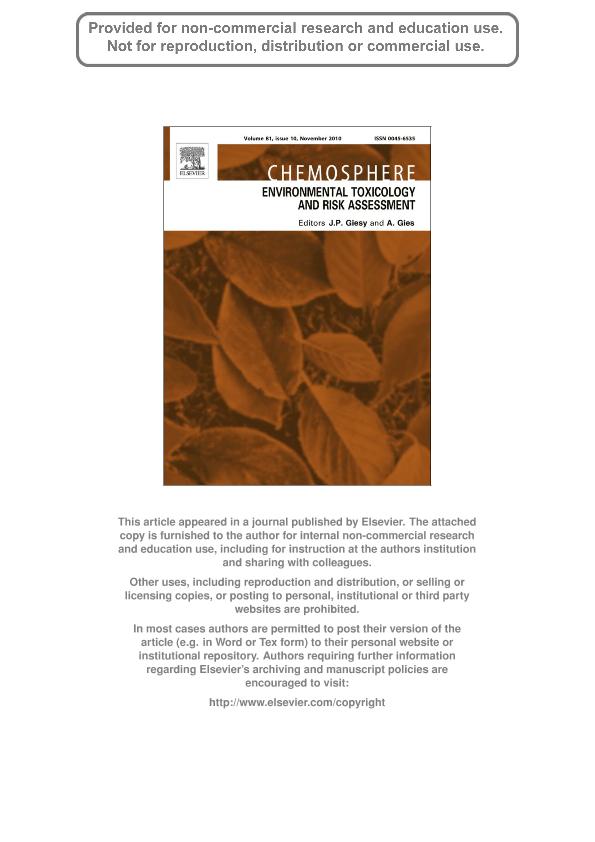Artículo
Predator-prey interactions between Synbranchus marmoratus (Teleostei: Synbranchidae) and Hypsiboas pulchellus tadpoles (Amphibia: Hylidae): Importance of lateral line in nocturnal predation and effects of fenitrothion exposure
Junges, Celina Maria ; Lajmanovich, Rafael Carlos
; Lajmanovich, Rafael Carlos ; Peltzer, Paola
; Peltzer, Paola ; Attademo, Andres Maximiliano
; Attademo, Andres Maximiliano ; Basso, Agustin
; Basso, Agustin
 ; Lajmanovich, Rafael Carlos
; Lajmanovich, Rafael Carlos ; Peltzer, Paola
; Peltzer, Paola ; Attademo, Andres Maximiliano
; Attademo, Andres Maximiliano ; Basso, Agustin
; Basso, Agustin
Fecha de publicación:
11/2010
Editorial:
Pergamon-Elsevier Science Ltd
Revista:
Chemosphere
ISSN:
0045-6535
Idioma:
Inglés
Tipo de recurso:
Artículo publicado
Clasificación temática:
Resumen
Environmental contaminants can disrupt interactions between aquatic species by altering community structure. We explored predator-prey interactions between marbled swamp juvenile eels (Synbranchus marmoratus; predator) and anuran tadpoles (Hypsiboas pulchellus; prey) in relation to two aspects: the importance of lateral line in the predator and whether the absence of light modifies predation rates; and the effect of a sub-lethal concentration of fenitrothion on both predator and prey. Eels were tested under two sensory conditions (lateral line intact and lateral line blocked by cobalt chloride) in dark conditions. Predation rates were evaluated using different treatments that combined predator and prey exposed or not to insecticide. Acetylcholinesterase (AChE) and butyrylcholinesterase (BChE) activities were also measured in muscle samples of eels and tadpoles to explore whether fenitrothion affects predator and prey differentially. Marbled swamp eels were more efficient in feeding on tadpoles during the night than during the day, showing that lateral line makes an important contribution to prey detection and capture. Regarding pesticide effects, short-term (6h) exposure to an ecologically relevant fenitrothion dose of 2.5mgL-1 altered the predator-prey relationship by changing prey behaviour, reducing prey detection and therefore increasing tadpole survival. At this concentration, the outcome of the predator-prey relationship appears biased in favor of the exposed tadpoles, which were released from predation risk, despite their altered behaviour and the higher inhibition percentages of tail BChE (70%) and AChE (51%) than in control individuals. Our study involving these model species and agrochemicals demonstrates that fenitrothion affected the outcome of a predator-prey relationship. Further studies are needed, in these species and other native amphibians, to investigate the nature of the mechanisms responsible for the adverse effects of pesticides on antipredator behaviour and predation efficiency.
Archivos asociados
Licencia
Identificadores
Colecciones
Articulos(CCT - SANTA FE)
Articulos de CTRO.CIENTIFICO TECNOL.CONICET - SANTA FE
Articulos de CTRO.CIENTIFICO TECNOL.CONICET - SANTA FE
Citación
Junges, Celina Maria; Lajmanovich, Rafael Carlos; Peltzer, Paola; Attademo, Andres Maximiliano; Basso, Agustin; Predator-prey interactions between Synbranchus marmoratus (Teleostei: Synbranchidae) and Hypsiboas pulchellus tadpoles (Amphibia: Hylidae): Importance of lateral line in nocturnal predation and effects of fenitrothion exposure; Pergamon-Elsevier Science Ltd; Chemosphere; 81; 10; 11-2010; 1233-1238
Compartir
Altmétricas



